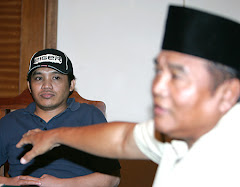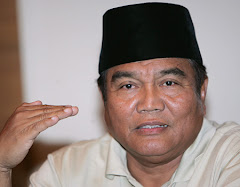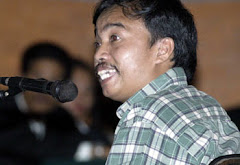
According to the Australian media, these terrorists are not being coerced and interrogated, they are having a party!
Thursday 5PM - Channel 10 only - Party Video Coverage
On Thursday the 11th of October 2007, in their 5.00PM broadcast, Australia’s Channel Ten Network showed video footage of the men responsible for killing over 200 people including 88 Australians in the Bali bombings of 2002.
We were told that what we were seeing were terrorists, unguarded and having a party in the home of Brigadier General Surya Dharma, Indonesia’s chief of anti-terror. As we listened to the voice-over narration, we learned that they were treated to kebabs on the very eve of the fifth anniversary of the Bali bombing.
In the same segment, survivors and relatives of the dead who had gathered at the Bali memorial were asked how they felt about the bombers being let out of prison to attend a 'celebration'. The reaction was predictable as these Australians, the segment's director chose to show, called for the terrorists to be put to death.
Thursday 10PM - Channel 10 only - bomb damage video.
However, later that night when the broadcast was repeated at 10.00PM, the video footage of the 'party' with it's scowling bombers and their unmoving, defensive body language was no longer there. Instead, while the story went unaltered, the footage of the bombers had been replaced with file footage of the bomb damage.
Friday Morning - All Channels - Selected Party stills
The next day on Friday morning, all Australian news services carried the story. John Howard, our Prime Minister, called the party “insensitive” and everyone thought that the Indonesian Authorities were being politically incorrect by giving Muslims favoured treatment. Certainly, with Dharma saying, “we are all Muslims and brothers,” and the bombers saying, “it would be wrong if our family members had been caught in the blast” this view was supported and further infuriated Australians.
However, all the 'party' vision for this story throughout Friday comprised of only a few selected still photographs even when the medium was television.
What really bothered me was that while the voice-over narrator spoke of a ‘party’ and kebabs, not one kebab was ever shown. I looked at the green, felt table. In front of each terrorist was an unopened bottle of water, an empty glass and a clean cup and saucer. No kebabs. The golden rule of journalism, ‘don’t tell if you can show’ was ignored and since the media has made such an issue of the kebabs why were none ever filmed or photographed?
And why were the journalists invited into Dharma’s home to begin with?
According to the Brigadier General, he was using the “soft approach of building up a web of paid informants and former militants working to persuade hard-liners to change sides and reject terrorism.” Such a strategy is in line with the on-going battle against terrorism and no one is making the case that the prisoners were to be denied food.
However, if the purpose was to convince the terrorists to abandon their beliefs and the people they conspired with, the worst tactic imaginable would be to televise them changing sides, especially in front of Australia's media on the eve of the anniversary of the Bali Bombing?
Since the most predictable effect was to enrage the Australian public so that many would demand the death penalty in spite of our nation's known and accepted opposition to it perhaps this obvious effect was the true intention all along.
Only two days prior to this in a speech on the Monday night, Australia’s opposition foreign affairs spokesman, Robert McClelland, had said a Labor government would lobby Asian countries to abolish the death penalty. This was the sentiment behind Phillip Ruddock calling Singapore "barbaric" when they hung Van Tuong Nguyen for heroin trafficking. So what was Mr. Howard and our government thinking when they said that Indonesia should put the Bali bombers to death?
Had they forgotten about the Bali Nine? It was bad enough when the Australian government informed Indonesian authorities that the Bali Nine were arriving to commit death penalty offences but this pro-death rhetoric for the terrorists was ensuring the uncontested death for six Australians.
If Australia demanded the death penalty for Indonesians we could hardly plead for clemency for Australians when it came to saving those of the Bali Nine who face execution.
In "Death for Sale" you will see how Schapelle Corby's life was saved on the very day that the Bali Nine were delivered to the Bali Police. It is difficult to believe that a deal was not struck to save Schapelle's life by bartering away the lives of heroin mules who were actually guilty. Having made this deal, any appeal for clemency for the Bali 9 would make our government appear disingenuous and such an appeal might be seen as reneging.
Because of this, our government required an alternative excuse to not put too much pressure on Indonesia. Rather than say, "We gave the Bali Nine to Indonesia; it would be rude to ask for them to be returned" they can now say, "We can not save Australians after we called for Indonesians to be executed."
Saturday Morning on - Internet news sites - the story remains but the photos are from the courtroom.
By Saturday Morning the story still dominated Australian web-sites. Those run by the media had removed all photos taken at the party. We still read about barbeques, kebabs, and a 'celebration' but instead of showing photographs of the topic being discussed, we instead see a three year-old photograph of Mubarok in court.
Was this because any close examination of these images revealed that no one but the Brigadier General was smiling at this 'party' or because it wasn't a party at all? Would people start to wonder what the media were doing there in the first place?
Or would it occur to all those web-surfers that no one outside of Australia was even aware of this party?
Only the Australian media were invited and no other nation carried the story. Therefore, from the moment the camera crew and photographers arrived they knew that the coverage would target Australians. What's more, since this anti-terror meeting took place in a private home of a senior policeman, the journalists could not have happened across this story by chance.
Who arranged for the the journalists to attend? Was it the Indonesian government? What is clear is that the photographs and video images did not match the media's slant of 'party', 'barbeque' or 'celebration' and so were removed as soon as it had been established that a meeting had occurred. It was therefore politically motivated propaganda.
Since every Australian media network's online news site continued to call this event a 'party' while replacing every shot taken in Dharma's house with an old courtroom file photo, all of our media acted in unison proving that this was not a decision made by editors but was directed from the very top.
In the convention of leaving the best until last: According to Indonesia's English language newspaper, "The Jakarta Post" in "Australia's Howard to protest Indonesian party for terrorists" of 12th of October, this so-called 'party' happened last month in September - a fact left out of Australia's media coverage.
It was the Australian media who sat on this story until after McClelland's speech. Didn't Mr Howard know this? They then aired it on the eve of the anniversary of the Bali Bombing. We were being manipulated but who was being insensitive?
On Thursday the 11th of October 2007, in their 5.00PM broadcast, Australia’s Channel Ten Network showed video footage of the men responsible for killing over 200 people including 88 Australians in the Bali bombings of 2002.
We were told that what we were seeing were terrorists, unguarded and having a party in the home of Brigadier General Surya Dharma, Indonesia’s chief of anti-terror. As we listened to the voice-over narration, we learned that they were treated to kebabs on the very eve of the fifth anniversary of the Bali bombing.
In the same segment, survivors and relatives of the dead who had gathered at the Bali memorial were asked how they felt about the bombers being let out of prison to attend a 'celebration'. The reaction was predictable as these Australians, the segment's director chose to show, called for the terrorists to be put to death.
Thursday 10PM - Channel 10 only - bomb damage video.
However, later that night when the broadcast was repeated at 10.00PM, the video footage of the 'party' with it's scowling bombers and their unmoving, defensive body language was no longer there. Instead, while the story went unaltered, the footage of the bombers had been replaced with file footage of the bomb damage.
Friday Morning - All Channels - Selected Party stills
The next day on Friday morning, all Australian news services carried the story. John Howard, our Prime Minister, called the party “insensitive” and everyone thought that the Indonesian Authorities were being politically incorrect by giving Muslims favoured treatment. Certainly, with Dharma saying, “we are all Muslims and brothers,” and the bombers saying, “it would be wrong if our family members had been caught in the blast” this view was supported and further infuriated Australians.
However, all the 'party' vision for this story throughout Friday comprised of only a few selected still photographs even when the medium was television.
What really bothered me was that while the voice-over narrator spoke of a ‘party’ and kebabs, not one kebab was ever shown. I looked at the green, felt table. In front of each terrorist was an unopened bottle of water, an empty glass and a clean cup and saucer. No kebabs. The golden rule of journalism, ‘don’t tell if you can show’ was ignored and since the media has made such an issue of the kebabs why were none ever filmed or photographed?
And why were the journalists invited into Dharma’s home to begin with?
According to the Brigadier General, he was using the “soft approach of building up a web of paid informants and former militants working to persuade hard-liners to change sides and reject terrorism.” Such a strategy is in line with the on-going battle against terrorism and no one is making the case that the prisoners were to be denied food.
However, if the purpose was to convince the terrorists to abandon their beliefs and the people they conspired with, the worst tactic imaginable would be to televise them changing sides, especially in front of Australia's media on the eve of the anniversary of the Bali Bombing?
Since the most predictable effect was to enrage the Australian public so that many would demand the death penalty in spite of our nation's known and accepted opposition to it perhaps this obvious effect was the true intention all along.
Only two days prior to this in a speech on the Monday night, Australia’s opposition foreign affairs spokesman, Robert McClelland, had said a Labor government would lobby Asian countries to abolish the death penalty. This was the sentiment behind Phillip Ruddock calling Singapore "barbaric" when they hung Van Tuong Nguyen for heroin trafficking. So what was Mr. Howard and our government thinking when they said that Indonesia should put the Bali bombers to death?
Had they forgotten about the Bali Nine? It was bad enough when the Australian government informed Indonesian authorities that the Bali Nine were arriving to commit death penalty offences but this pro-death rhetoric for the terrorists was ensuring the uncontested death for six Australians.
If Australia demanded the death penalty for Indonesians we could hardly plead for clemency for Australians when it came to saving those of the Bali Nine who face execution.
In "Death for Sale" you will see how Schapelle Corby's life was saved on the very day that the Bali Nine were delivered to the Bali Police. It is difficult to believe that a deal was not struck to save Schapelle's life by bartering away the lives of heroin mules who were actually guilty. Having made this deal, any appeal for clemency for the Bali 9 would make our government appear disingenuous and such an appeal might be seen as reneging.
Because of this, our government required an alternative excuse to not put too much pressure on Indonesia. Rather than say, "We gave the Bali Nine to Indonesia; it would be rude to ask for them to be returned" they can now say, "We can not save Australians after we called for Indonesians to be executed."
Saturday Morning on - Internet news sites - the story remains but the photos are from the courtroom.
By Saturday Morning the story still dominated Australian web-sites. Those run by the media had removed all photos taken at the party. We still read about barbeques, kebabs, and a 'celebration' but instead of showing photographs of the topic being discussed, we instead see a three year-old photograph of Mubarok in court.
Was this because any close examination of these images revealed that no one but the Brigadier General was smiling at this 'party' or because it wasn't a party at all? Would people start to wonder what the media were doing there in the first place?
Or would it occur to all those web-surfers that no one outside of Australia was even aware of this party?
Only the Australian media were invited and no other nation carried the story. Therefore, from the moment the camera crew and photographers arrived they knew that the coverage would target Australians. What's more, since this anti-terror meeting took place in a private home of a senior policeman, the journalists could not have happened across this story by chance.
Who arranged for the the journalists to attend? Was it the Indonesian government? What is clear is that the photographs and video images did not match the media's slant of 'party', 'barbeque' or 'celebration' and so were removed as soon as it had been established that a meeting had occurred. It was therefore politically motivated propaganda.
Since every Australian media network's online news site continued to call this event a 'party' while replacing every shot taken in Dharma's house with an old courtroom file photo, all of our media acted in unison proving that this was not a decision made by editors but was directed from the very top.
In the convention of leaving the best until last: According to Indonesia's English language newspaper, "The Jakarta Post" in "Australia's Howard to protest Indonesian party for terrorists" of 12th of October, this so-called 'party' happened last month in September - a fact left out of Australia's media coverage.
It was the Australian media who sat on this story until after McClelland's speech. Didn't Mr Howard know this? They then aired it on the eve of the anniversary of the Bali Bombing. We were being manipulated but who was being insensitive?


